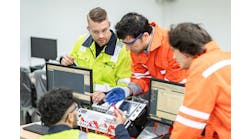The first programmable logic controller (PLC) was developed by Dick Morley, an engineer at Bedford and Associates, in 1968. The Modicon 084, so named because it was Bedford’s 84th project, was designed and created for General Motors as an alternative to hardwired control systems based on relays.
The Modicon 084 was significant because it allowed engineers to reprogram machinery without rewiring physical connections. This adaptability revolutionized machine control.
The PLC is an industrial computer that controls and automates electromechanical machinery for manufacturing applications. PLCs are designed to communicate with digital and analog input and output (I/O) devices, accepting information from sensors and switches and executing logic to manage motion actuators and production.
Like a computer, the PLC contains a processor, responsible for executing a program that instructs it how to read inputs, process logic and generate output. It utilizes random access memory (RAM) to store control-program and temporary data, and it has read-only memory (ROM) to accommodate the firmware and the operating system required to run the PLC.
PLC programming is based on the IEC 61131-3, which includes higher-level languages, such as ladder diagram (LD), instruction list (IL), structured text (ST), function block diagram (FBD) and sequential function chart (SFC).
The PLC is designed to operate in real time, so it can respond to analog or digital inputs and execute logic in a deterministic fashion, ensuring timeliness and accuracy.
Because they are manufactured for industrial applications, PLCs include ruggedized hardware and the ability to withstand temperature extremes, debris or vibration in harsh environments.
Additional I/O modules can be included to expand PLC-based control systems. This provides adaptability and scalability to production capabilities as processes grow.
A variety of communication protocols, such as Ethernet, Modbus, EtherNet/IP, Profinet/Profibus, common industrial protocol (CIP), CANopen and EtherCAT, are supported by PLCs, allowing for the exchange of data with other devices or systems, including human-machine interfaces (HMIs) and supervisory control and data acquisition (SCADA) systems, as well as other PLCs. RS-232 still provides reliable means of communication, as well.
In addition to monitoring and managing operations, programmable logic controllers have evolved to assume additional functions.
PLCs can store and retrieve data, making them suitable for data logging and reporting in quality-control applications or tracking production. A PLC also can monitor its own status and detect faults or errors, as well as provide diagnostic information to help with troubleshooting. PLCs can be programmed to implement safety functions, such as emergency shutdowns, interlocks and safety alarms, as well.
A PLC can be used to control an assembly line, manage complex industrial processes in automotive or other discrete manufacturing, food processing and chemical production.
The PLC is the brains of manufacturing automation. It can control assembly lines, robotic arms and conveyance systems. Automotive manufacturing relies on PLCs to control welding robots and paint booths, as well as assembly lines. PLCs oversee batch processing, quality control and packaging in food and beverage. Their precision and reliability make sure temperatures are consistent, keeping products safe.
The evolution of the PLC sired the programmable automation controller (PAC), which is similar in nature to the PLC as well as PC-based control.





